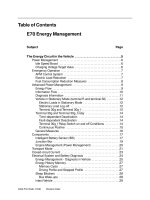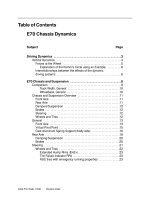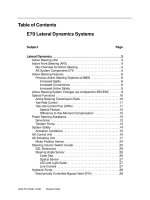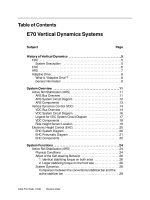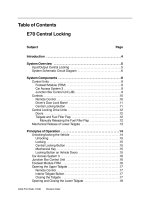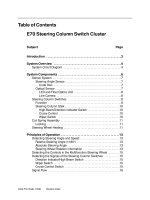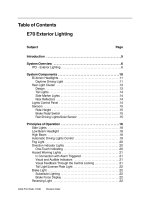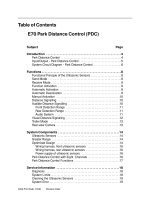Xe ô tô BMW X5 E70 SM 04b_E70 Lateral Dynamics Systems
Bạn đang xem bản rút gọn của tài liệu. Xem và tải ngay bản đầy đủ của tài liệu tại đây (692.09 KB, 29 trang )
Initial P
rint
Dat
e: 10/06
Table of Contents
Subject Page
Lateral Dynamics . . . . . . . . . . . . . . . . . . . . . . . . . . . . . . . . . . . . . . . . . . . . . .3
Active Steering (AS) . . . . . . . . . . . . . . . . . . . . . . . . . . . . . . . . . . . . . . . . . . . .3
Active Front Steering (AFS) . . . . . . . . . . . . . . . . . . . . . . . . . . . . . . . . . . . . . .4
Bus Overview for Active Steering . . . . . . . . . . . . . . . . . . . . . . . . . . . . . .4
AS System Components E70 . . . . . . . . . . . . . . . . . . . . . . . . . . . . . . . . .5
Active Steering Features . . . . . . . . . . . . . . . . . . . . . . . . . . . . . . . . . . . . . . . .8
Previous Active Steering Systems at BMW . . . . . . . . . . . . . . . . . . . . . .8
Increased Agility . . . . . . . . . . . . . . . . . . . . . . . . . . . . . . . . . . . . . . . . . .8
Increased Convenience . . . . . . . . . . . . . . . . . . . . . . . . . . . . . . . . . . . .8
Increased Active Safety . . . . . . . . . . . . . . . . . . . . . . . . . . . . . . . . . . . .9
Active Steering System Changes (as compared to E6X/E9X) . . . . . . . .9
Special Functions . . . . . . . . . . . . . . . . . . . . . . . . . . . . . . . . . . . . . . . . . . . . .10
Active Steering Transmission Ratio . . . . . . . . . . . . . . . . . . . . . . . . . . . .10
Yaw Rate Control . . . . . . . . . . . . . . . . . . . . . . . . . . . . . . . . . . . . . . . . . . .11
Yaw-rate Control Plus (GRR+) . . . . . . . . . . . . . . . . . . . . . . . . . . . . . . . .11
Special Feature . . . . . . . . . . . . . . . . . . . . . . . . . . . . . . . . . . . . . . . . . .12
Difference to Yaw Moment Compensation: . . . . . . . . . . . . . . . . .12
Power Steering Assistance . . . . . . . . . . . . . . . . . . . . . . . . . . . . . . . . . . . . .13
Servotronic . . . . . . . . . . . . . . . . . . . . . . . . . . . . . . . . . . . . . . . . . . . . . . . . .13
Tandem Pump . . . . . . . . . . . . . . . . . . . . . . . . . . . . . . . . . . . . . . . . . . . . . .13
System Safety . . . . . . . . . . . . . . . . . . . . . . . . . . . . . . . . . . . . . . . . . . . . . . . .14
Activation Conditions . . . . . . . . . . . . . . . . . . . . . . . . . . . . . . . . . . . . . . . .15
AS Control Unit . . . . . . . . . . . . . . . . . . . . . . . . . . . . . . . . . . . . . . . . . . . . . . .15
AS Actuating Unit . . . . . . . . . . . . . . . . . . . . . . . . . . . . . . . . . . . . . . . . . . . . .17
Mot
or Position Sensor . . . . . . . . . . . . . . . . . . . . . . . . . . . . . . . . . . . . . . .24
Steering Column Switch Cluster . . . . . . . . . . . . . . . . . . . . . . . . . . . . . . . .25
SZL Electronics . . . . . . . . . . . . . . . . . . . . . . . . . . . . . . . . . . . . . . . . . . . . .26
Steering Angle Sensor . . . . . . . . . . . . . . . . . . . . . . . . . . . . . . . . . . . . . .26
Code Disc . . . . . . . . . . . . . . . . . . . . . . . . . . . . . . . . . . . . . . . . . . . . . .26
Optical Sensor . . . . . . . . . . . . . . . . . . . . . . . . . . . . . . . . . . . . . . . . . .27
LED and Light Guide . . . . . . . . . . . . . . . . . . . . . . . . . . . . . . . . . . . . .27
Line Camera . . . . . . . . . . . . . . . . . . . . . . . . . . . . . . . . . . . . . . . . . . . .27
Hydraulic Pump . . . . . . . . . . . . . . . . . . . . . . . . . . . . . . . . . . . . . . . . . . . . . . .28
Electronically Controlled Bypass Valve (EVV) . . . . . . . . . . . . . . . . . . .28
E70 Lateral Dynamics Systems
R
e
vision Dat
e:
2
E70 Lateral Dynamics Systems
Lateral Dynamics Systems
Model: E70
Production: From Start of Production
After completion of this module you will be able to:
• Describe changes to the Active Steering System
• Understand Servotronic operation in the E70
Nowadays, dynamic driving systems are subdivided according to their mode of operation
within the three axis co-ordinates and classified according to function.
In the E70, there are two systems which count as lateral dynamics systems. Lateral
dynamics systems (effective direction mainly along the y or lateral axis):
• Servotronic - Speed-dependent hydraulic steering torque assistance
• AS - Active Steering (previously AFS, Active Front Steering)
The E70 is the first all-wheel-drive vehicle to be offered with Active Steering (AS)
Servotronic is only offered in conjunction with the Active Steering.
Active Steering (AS)
Active Steering was initially offered in the E60 (5 Series). Since then, a large proportion
of BMWs in the 3 and 6 Series now have Active Steering. It is only the X models and
other all-wheel-drive vehicles that have not yet been provided with this for reasons of
space.
This innovative steering system is now being offered in an all-wheel-drive vehicle for the
first time at BMW, namely in the E70.
3
E70 Lateral Dynamics Systems
Lateral Dynamics
Active Front Steering (AFS)
Bus Overview for Active Steering
4
E70 Lateral Dynamics Systems
Index Explanation Index Explanation
C
AS
Car Access System
DSC
Dynamic Stability Control
KOMBI
Instrument Cluster
AL
Active Steering
JB
Junction Box
DME
Digital Motor Electronics
DSC_SEN
DSC Sensor
SZL
Steering Column Switch Cluster
AS System Components E70
5
E70 Lateral Dynamics Systems
Inde
x
Explanation Inde
x
Explanation
1
DSC Sensor
5
Fluid r
eservoir
2
Steering Column Switch Cluster
6
Steering gear
3
AS control unit
7
Hydraulic pump
4
AS actuating unit
8
P
ower steering cooler
A
S System Overview
6
E70 Lateral Dynamics Systems
L
egend for AS System Overview
7
E70 Lateral Dynamics Systems
Index Explanation Index Explanation
1
Wheel speed sensor, front left
9
Wheel speed sensor, front right
2
Solenoid lock
10
Junction box
3
A
S control unit
11
D
SC sensor
4
AS actuating unit
12
Wheel speed sensor, rear left
5
EVV (Electronically Controlled Bypass Valve)
13
Wheel speed sensor, rear right
6
Digital Motor Electronics
14
Brake light switch
7
Dynamic Stability Control
15
Steering column switch cluster
8
Servotronic valve
16
Instrument cluster
Active Steering Features
Previous Active Steering Systems at BMW
The dynamic steering system known as Active Steering was used for the first time in the
world by BMW in the E60. The "variable steering-transmission ratio" is adjusted to the
optimum ratio for all road speeds. During this process and depending on the road speed,
an electric motor uses a worm drive to mesh with a special planetary gearbox with over-
ride function and gear into the steering chain.
This allows the steering system to generate a greater or reduced steering angle at the
front wheels depending on the driving situation. Since it was implemented in the E90,
Active Steering is also able to intervene in critical dynamic driving situations (braking with
different friction coefficients on the left and right) by correcting the steering angle if the
vehicle starts to become unstable using so-called yaw moment compensation.
This stabilizes the vehicle more quickly than the driver could. Active Steering thus
reduces intervention in the lower DSC control range and thereby provides optimum:
• Agility
• Comfort
• Active safety
Increased Agility
Due to the direct transmission ratio, the vehicle is perceived as having a greater agility and
handling performance up into the mid driving speed range (approximately 100 km/h).
The driver also has far greater control when swerving, for example - this combined with
considerably enhanced steering precision and reduced steering effort. Direct contact
with the road via the steering wheel is maintained throughout.
Increased Convenience
Some previous steering systems have required more than 3 full steering-wheel turns to
achieve a full wheel lock from the far left over to far right. Active Steering reduces this at
low speeds to less than 2 steering-wheel turns from lock to lock.
The benefit: less steering effort is required when turning in city traffic or maneuvering in
narrow parking spaces. On twisting roads in mountainous regions, for example, the
reduced steering wheel angle also ensures that hands always remain in the optimum
position on the steering wheel, which means that crossing of hands, or even arms in
some cases, is no longer necessary. The multifunction buttons on the steering wheel or
the gearshift paddles for the sequential manual transmission (SMG) therefore always
remain conveniently within reach during every road situation.
8
E70 Lateral Dynamics Systems
Increased Active Safety
At higher speeds, the transmission ratio of the Active Steering is more indirect. This
means that a rotational movement of the steering wheel generates a smaller steering
angle than at lower speeds.
This results in more comfortable directional stability. The effects of "snatching" the
steering wheel, e.g. in a frightening situation, are considerably lessened by this. An assist-
ing intervention by the Active Steering counteracts yawing forces and rotational move-
ments of the vehicle around its vertical axis when they first occur by correcting the steer-
ing angle of the wheel. Yawing forces (without active brake intervention) occur when the
vehicle changes lane or swerves or when the load changes under cornering.
Active Steering electronically controls the stabilization function at all speeds without the
driver being aware of this. It also assists the driver by actively counter-steering when
there are different friction coefficients under braking.
Active Steering System Changes (as compared to E6X/E9X)
For the first time, the customer can choose between standard power steering and the
innovative Active Steering system in a BMW all-wheel-drive vehicle.
Details in which the Active Steering in the E70 differs from those which are familiar in
other series:
• No physical cumulative steering-angle sensor
• Virtual cumulative steering angle provides the same information as cumulative
steering-angle sensor
• Virtual cumulative steering angle describes the exact position of the rack and pinion
• Virtual cumulative steering angle as reference for adjustment of track alignment (vir-
tual steering angle "0" = rack and pinion exactly centered
• Virtual cumulative steering angle is calculated from the driver steering angle and
motor position angle
• If the motor position angle is lost or discarded, the position of the rack and pinion is
unknown and must be relearned, i.e. initialize the Active Steering.
• Instead of yaw moment compensation, the E70 has yaw-rate control plus (GRR+)
• Initialization has changed
• There is no longer an ECO valve on the hydraulic pipe. It has been replaced by a
new valve: Electronically Controlled Bypass Valve (EVV)
• The wheel alignment check with KDS has a ne
w feature that must be taken into
consideration.
9
E70 Lateral Dynamics Systems
Special Functions
Active Steering Transmission Ratio
The Active Steering varies the steering-gear ratio as a function of the road speed and the
steering angle requested by the driver. The steering is designed to be indirect at high
speeds. At lower speeds, the steering is more direct.
The ease of handling the vehicle at low speeds or when parking is greatly increased by
the Active Steering actuating unit. It is no longer necessary to grapple with the steering
wheel.
Just two turns of the steering wheel when the vehicle is stationary are enough to move
the steering wheel from one lock to the other. At high road speeds (> 120 km/h), the
Active Steering allows a more indirect transmission ratio than in conventional steering
systems. The electric motor operates against the steering wheel angle at high speeds.
Together with the elevated steering torque level (Servotronic), this has the effect of con-
siderably improving the vehicle's directional stability.
10
E70 Lateral Dynamics Systems
Index Explanation Index Explanation
1
Active steering design
3
Road speed
2
Conventional design
4
Ratio
Yaw Rate Control
If the vehicle is threatening to oversteer, the Active Steering stabilizes the vehicle with a
slight correction to the angle of attack of the front wheels.
Example: The driver initiates a rapid lane change. This change in direction causes a
certain tendency to oversteer in the vehicle.
As the control thresholds for a DSC stabilization intervention are not yet reached in this
case, the angle of attack of the wheels is slightly adjusted (maximum ± 4°) by the Active
Steering. The vehicle is stabilized by this active damping, but the driver does not feel it
through the steering wheel.
Yaw-rate Control Plus (GRR+)
The "yaw-rate control plus" function assists the driver when he is braking on roads with
varying friction coefficients, in a similar way to the yaw moment compensation. This func-
tion represents a significant safety feature.
In the case of braking on different surface friction coefficients (asphalt/ice or snow), a
moment builds up about the z or vertical axis (yaw moment) rendering the vehicle unsta-
ble. In
this special case, the Active Steering control unit calculates the steering angle
(maximum ±4°) required for the front wheels to keep the vehicle stable using the actual
yaw rate and the longitudinal and lateral acceleration.
11
E70 Lateral Dynamics Systems

